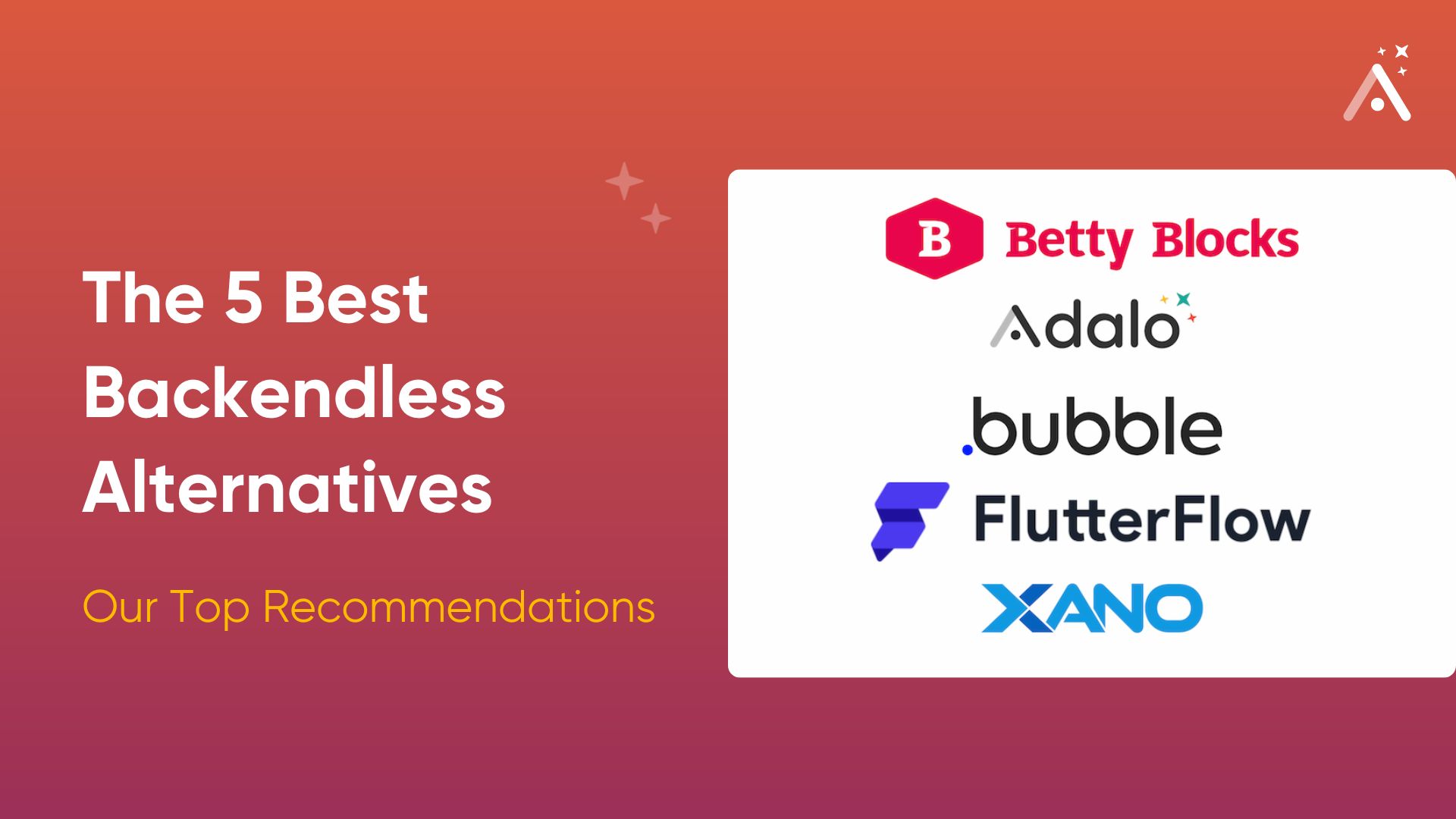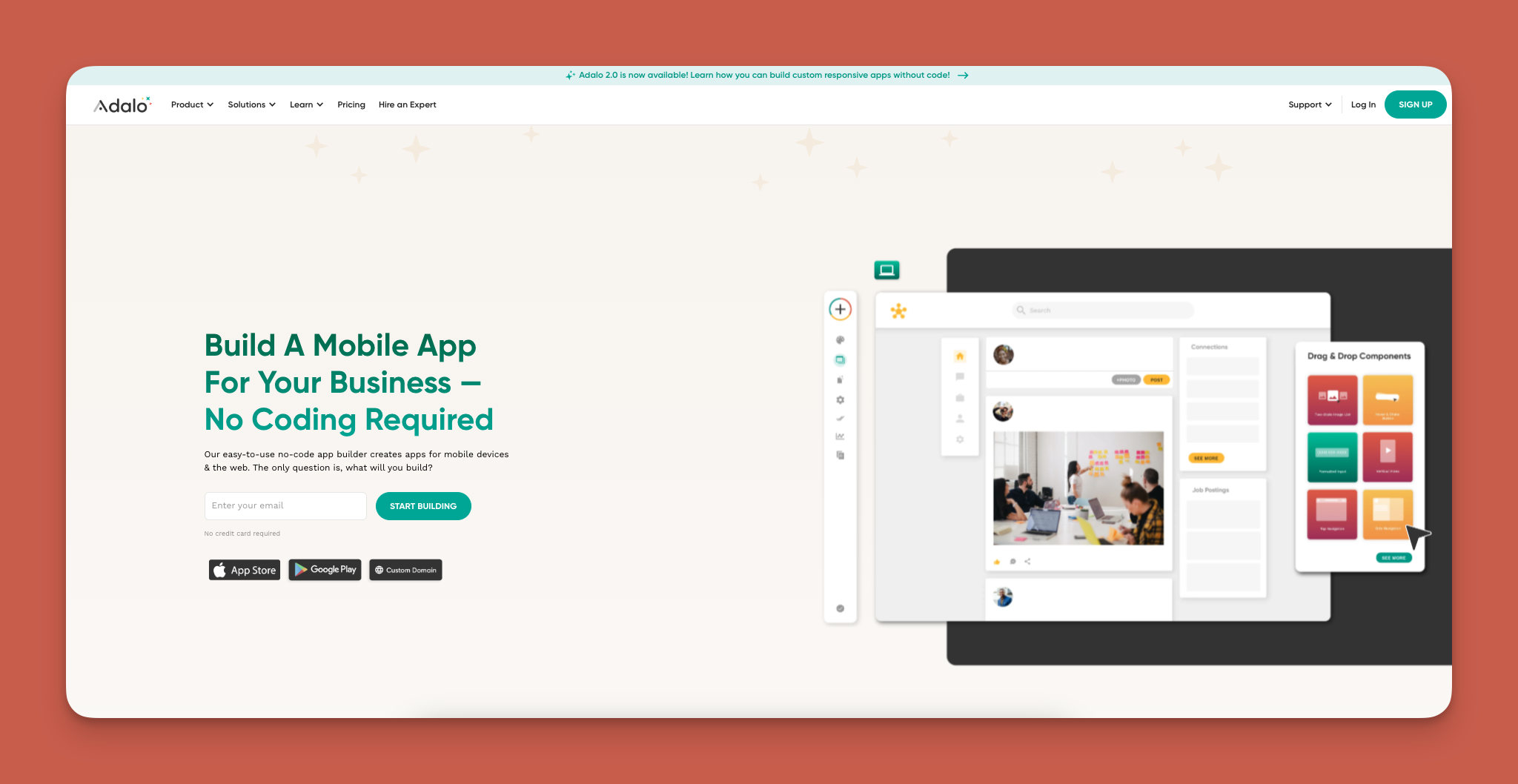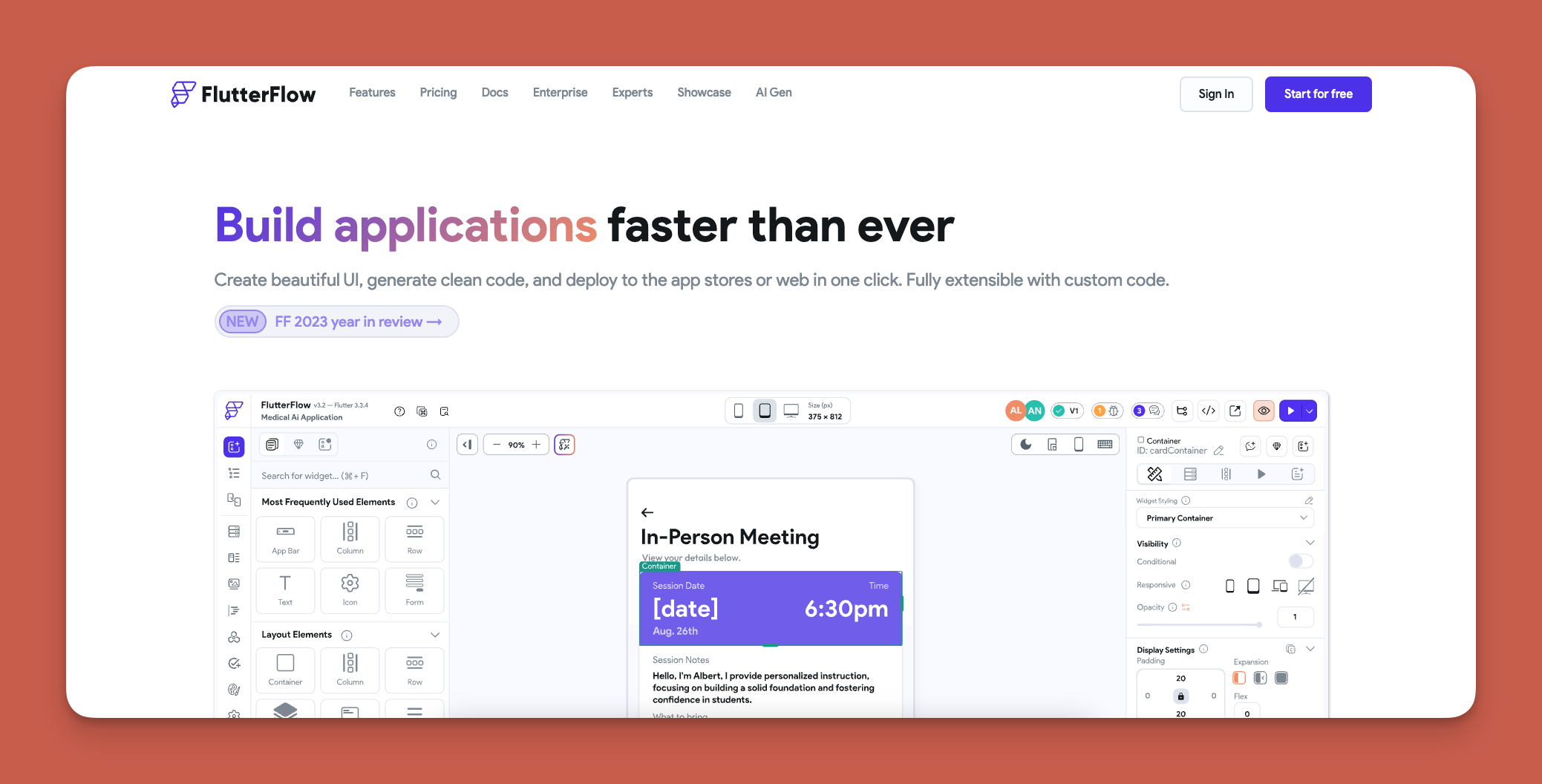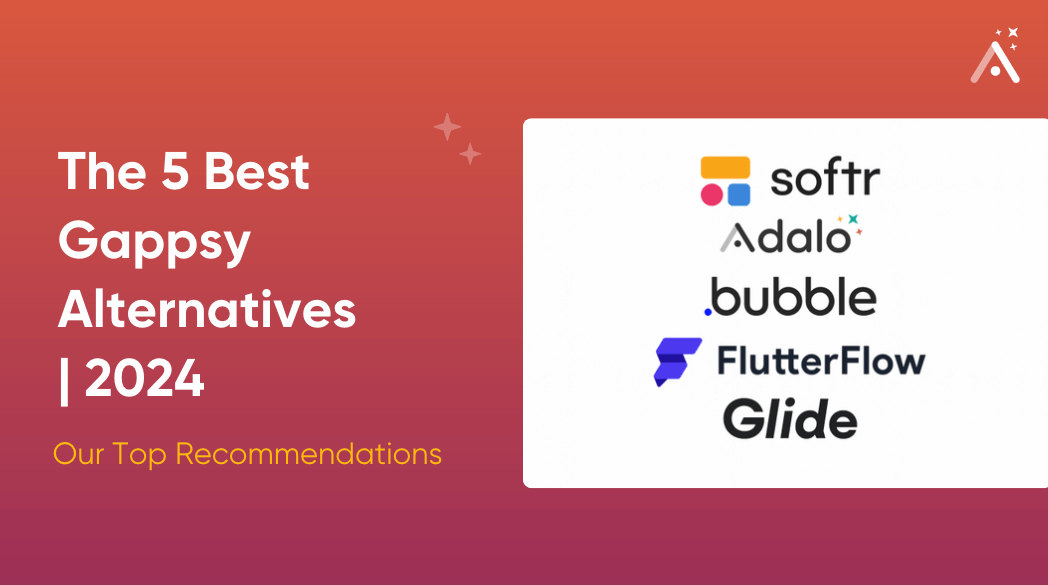Backendless tries to appeal to the non-technical crowd by marketing itself as a no-code, easy-to-use app-building platform. While it does have a few intuitive features, many folks rush to seek an alternative after trying to understand Backendless’s complexities.
If you’re one of those folks looking for greener pastures, look no further. I’ve been recommending no-code app builders to entrepreneurs, businesses, and organizations for over 10 years.
After reviewing over 250 no-code app-building platforms, I have a good grasp of what people seeking a Backendless alternative want. In this article, I’ll go over my top 5 Backendless alternatives.

Why Choose a Backendless Alternative?
Backendless gives users the ability to create their app’s front end, which is the part of the app that users see and interact with, and their app’s backend, which is the app’s database, logic, and place where information is processed.
Unfortunately, Backendless’s building platform and accessibility are a bit more complex than those of typical no-code platforms. Time and again, I’ve heard the following complaints about Backendless:
Learning Curve and Technical Knowledge Requirements
Backendless provides its own block-based system, Codeless, for building your backend. In a nutshell, you connect different blocks that represent specific functionalities together to build your backend.
While this may sound easy, it actually comes with a difficult learning curve. You’ll need to fully understand the specific roles and functions of each block. Doing this requires watching Backendless’s 4.5-hour video tutorial library, and reading up on its help guides.
In order to get the most out of Backendless, you’ll also need to have certain technical skills, like knowing how to properly structure your database, how APIs work, and having simple JavaScript language skills. This is daunting, especially if you’re strapped for time.
Solution: Pick an app-building platform, like Adalo, that you can use right out of the box. You won’t need to know technical concepts, coding languages, or complex data structures. Just start building after you sign up.
Catered to Large Organizations
Backendless does have a version available for small and medium businesses, but it's quite limited in terms of storage capacity and the number of tasks it can execute. If you want Backendless’s full package of perks, you’ll need to go with one of the versions built for scaling and priced for large organizations — nearly $1,000/month.
Solution: Use an app builder like Adalo, Bubble, or FlutterFlow, which offers versions for freelancers, entrepreneurs, and small and medium businesses. These builders provide all the power you need to build the app you want.
Can Get Expensive
While Backendless has an affordable $15/month version, you only get minimal database, storage, and other features. However, you can add specific features and functionalities at a cost per feature and functionality. Additionally, Backendless charges you whenever a user accesses data through an API.
These additional costs can add up to substantially more than $15/month, especially if you have a large app.
Solution: Select a reasonably priced app-building platform, like Adalo or Bubble, that charges a flat rate per month and gives you lots of power. This will help put your mind at ease, as you won’t be worrying about the total amount of API calls your users made last month or if you need to purchase additional storage space.
The Top 5 Backendless Alternatives
- Adalo, the best overall Backendless alternative
- Bubble, the Backendless alternative with the most robust ecosystem
- FlutterFlow, the best Backendless alternative for developers
- Xano, the best Backendless alternative for backend building
- Betty Blocks, the best Backendless alternative for enterprises
#1 The Best Overall Backendless Alternative
Adalo

What is it?
Adalo is a no-code native mobile app builder that combines design freedom and power to let you bring any app idea to life.
What does it do better than Backendless?
While Backendless has a steep learning curve and requires knowledge of technical concepts before you can start making your app, it’s quite the opposite with Adalo.
When you build your app with Adalo, you can start building immediately after signing up — you don’t need any technical knowledge, and you won’t have to dedicate several hours to learning your building interface.
Adalo’s templates have a pre-made backend and database, with the logic and functionality already baked in. You also won’t need to spend any time painfully constructing your database. You can easily edit your data schema as if it were an Excel sheet.
Whenever you add a new function, it automatically integrates with your app’s backend, saving time. After you finish building your app, you can publish it in the Apple App Store or Google Play Store so your users can easily download it.
Who is it best for?
Adalo is the perfect choice for freelancers, entrepreneurs, and small and medium businesses. Over the last decade, I’ve recommended Adalo more than any other app-building platform because it has the flexibility and power to create any app for any purpose.
Pricing
Adalo’s pricing starts at $36/month.
Final Verdict
With competitive pricing, ease of use, and no need for any technical knowledge, Adalo is the best overall Backendless alternative.
#2 The Backendless with the Biggest Ecosystem
Bubble

What is it?
Bubble is a battle-tested, no-code web app builder with a powerful building interface.
What does it do better than Backendless?
Bubble has been around since 2012, making it one of the longest-running app-building platforms in existence. One of the fruits of its longevity is an enormous ecosystem packed with tutorials, templates, APIs made by the Bubble Developer Community, a thriving forum, and more.
When you sign up with Bubble, you’ll be able to access this ecosystem and better understand the app-building interface. While Bubble does come with a learning curve, it’s not as difficult as Backendless, and you won’t need to know any tech concepts to create your app with Bubble.
Who is it best for?
Everyone from freelancers to large enterprises can use Bubble to build any sort of app to suit their business needs. While Bubble doesn’t make native mobile apps, you can use it to create powerful web apps that users can access on their phone browsers.
Pricing
Bubble lets you publish a live app for $32/month (billed monthly). If you want an app with more complexity and functionality, such as 100GB of storage space and 2-factor authentication, go with Bubble’s growth version, which costs $134/month (billed monthly).
Final Verdict
Although it has a bit of a learning curve, Bubble is the Backlendess alternative with a thriving ecosystem, which makes it much easier to learn and use than Backendless.
#3 The Backendless Alternative for Developers
FlutterFlow

What is it?
FlutterFlow is a low-code native mobile and web app builder that brings with it features and functionality that will make developers drool.
What does it do better than Backendless?
Just like with Backendless, you’ll need some programming experience and technical knowledge to get started with FlutterFlow. Unlike Backendles, you won’t need to learn a building block system like Codeless to create your backend.
FlutterFlow is built on Firebase, so you’ll have the power to set up your backend quickly. When you finish building your app, FlutterFlow lets you keep your own code so you can add your own niche features not found on FlutterFlow’s building interface.
Conveniently, FlutterFlow also allows you to publish your apps to the Apple App Store and Google Play Store.
Who is it best for?
If you want to use FlutterFlow, you need to have technical experience. Those lacking it will struggle.
Pricing
Get FlutterFlow to download your app’s code for $30/month (billed monthly). If you want more features, such as enhanced security and testing functionalities, you’ll need to go with the $70/month (billed monthly) version.
Final Verdict
Because you can use your technical knowledge to build your app and don’t need to learn programming systems like Codeless, FlutterFlow is the best Backendless alternative for developers.
#4 The Backendless Alternative for Backend Building
Xano

What is it?
Xano is an easy-to-use, no-code backend builder that lets you create your database, logic, and other backend functionalities with ease.
What does it do better than Backendless?
Unlike Backendless, Xano doesn’t require much technical knowledge to use, although having some idea of IT concepts will help. And if you get stuck at any time when you’re building your app, Xano has you covered: They offer 24/7 support and even provide a phone number on their site.
Because Xano is Turing complete, which means it can solve any computing problem presented to it, you can build anything into your backend. Xano is useful for businesses of all sizes and covers the needs of those who only need a small backend or the more ambitious types that want to scale to millions of users.
Who is it best for?
Folks who are looking to only build out their backend will be right at home with Xano. And if you’re an Adalo user, you’ll be able to easily integrate your Xano backend into your Adalo app.
Pricing
Xano has a free version that lets you store up to 100,000 records in your database. For $99/month (billed monthly), you can get unlimited data records and the ability to test your data sources.
Final Verdict
If you just want to build a powerful backend, Xano is the Backendless alternative that allows you to do so with little fuss.
#5 The Best Backendless Alternative for Enterprises
Betty Blocks

What is it?
Betty Blocks is a no-code native mobile app builder that is marketed toward large organizations, big businesses, and Fortune 500 companies.
What does it do better than Backendless?
Betty Blocks leverages a fully no-code drag-and-drop interface, making it easy to build your app. But, because big organizations tend to have team members with tech expertise, you’ll also have the option to code in your own special features.
When you onboard with Betty Blocks, they’ll customize a plan of features to meet your specific needs. Plus, you’ll have the option to host your app on-prem (on your own servers), which is a huge advantage for any enterprise because you get better security and more control.
Who is it best for?
Betty Blocks is exclusively designed to meet the needs of huge organizations with 1,000s of employees. It doesn’t have any versions for small or medium-sized businesses.
Pricing
Betty Blocks doesn’t publish its pricing, so you’ll need to contact them to learn more.
Final Verdict
Because Betty Blocks is willing to customize its offering to your specific needs, Betty Blocks is the best Backendless alternative for large enterprises.
Frequently Asked Questions
What is the Cheapest Backendless Alternative?
FlutterFlow, at $30/month (billed monthly), and Bubble, at $24/month (billed monthly), are the least expensive Backendless alternatives. But you’ll need to be a developer to use FlutterFlow, and you’ll need to spend some time mastering Bubble’s learning curve.
If you want a competitively priced app builder that you can use right out of the box without any learning curve or the need for technical knowledge, look no further than Adalo at $36/month.
What is the Easiest Backendless Alternative?
With a super intuitive drag-and-drop interface that you can use to build your app immediately after signing up, Adalo is the easiest Backendless alternative. You’ll need no prior knowledge in coding or tech to use Adalo.
What is the Best Backendless Alternative for Big Businesses?
FlutterFlow, Bubble, Xano, and Betty Blocks are good choices for large businesses. But if you want to run your app on your own servers, check out Betty Blocks, as it’s specifically designed to do so.
.png)

















